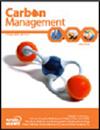A blue carbon pilot project: Lessons learned
IF 2.8
4区 环境科学与生态学
Q3 ENVIRONMENTAL SCIENCES
引用次数: 1
Abstract
Abstract Here we describe a pilot wetland carbon project located 30 km west of New Orleans where measurements were taken in 2013 and 2018, and applied to a carbon offset methodology published by the American Carbon Registry (ACR). Baseline emissions were modeled using values derived from scientific literature, which resulted in a net sequestration rate of 16,527 t CO2-e (tons carbon dioxide equivalents) per year if wetland greenhouse gases (CH4 & N2O) were included (619,727 over the 40-year project duration), and 5,003 t CO2-e/yr if wetland greenhouse gases were conservatively omitted (200,143 t CO2e over 40 years). Alternatively, a kriging exercise was carried out that modeled the tree and soil pools, resulting in higher net sequestration of 18,084 t CO2-e/yr with greenhouse gases (723,375 t CO2-e over 40 years), and 6,560 t CO2-e/yr if greenhouse gases were omitted (262,472 t CO2-e over 40 years). Unfortunately, the project was withdrawn, prohibiting the issuance and eventual transaction of carbon credits, due to very large uncertainty estimates mostly associated with methane and nitrous oxide emissions as well as the kriging approach since in situ sampling could not be carried out as required by the methodology. Next steps to increase the commercial viability of wetland carbon offsets include: closing knowledge gaps in wetland emissions of methane and nitrous oxide; developing means to reduce costs of monitoring, reporting and verification; fully accounting for prevented loss; developing remote sensing methods for monitoring and verification; and development of biogeochemical models to predict methane and nitrous oxide fluxes and sequestration pools. Though the project did not generate carbon credits, the results and lessons learned are intended to inform managers, and blue carbon project developers on how to develop wetland carbon credits that are high quality, economically competitive, and scientifically defensible.蓝碳试点项目:经验教训
摘要在这里,我们描述了一个位于30 2013年和2018年在新奥尔良以西km处进行了测量,并应用于美国碳登记局(ACR)发布的碳抵消方法。使用科学文献中得出的值对基线排放量进行建模,如果包括湿地温室气体(CH4和N2O),则每年的净固存率为16527吨二氧化碳当量(吨二氧化碳当量)(在40年的项目期限内为619727吨),如果保守地忽略湿地温室气体,则每年为5003吨二氧化碳当量 年)。或者,进行克里格法模拟树木和土壤池,导致温室气体净固存量增加18084吨二氧化碳当量/年(723375吨二氧化碳当量超过40 年),如果省略温室气体,则为6560吨二氧化碳当量/年(262472吨二氧化碳当量超过40 年)。不幸的是,该项目被撤回,禁止发放和最终交易碳信用,因为主要与甲烷和一氧化二氮排放有关的不确定性估计非常大,以及克里格方法,因为无法按照该方法的要求进行现场采样。提高湿地碳抵消商业可行性的下一步措施包括:缩小湿地甲烷和一氧化二氮排放方面的知识差距;制定降低监测、报告和核查费用的手段;充分核算防止损失;制定监测和核查的遥感方法;以及开发生物地球化学模型来预测甲烷和一氧化二氮的通量和固存池。尽管该项目没有产生碳信用,但其结果和经验教训旨在告知管理人员和蓝碳项目开发商如何开发高质量、具有经济竞争力和科学依据的湿地碳信用。
本文章由计算机程序翻译,如有差异,请以英文原文为准。
求助全文
约1分钟内获得全文
求助全文
来源期刊

Carbon Management
ENVIRONMENTAL SCIENCES-
CiteScore
5.80
自引率
3.20%
发文量
35
期刊介绍:
Carbon Management is a scholarly peer-reviewed forum for insights from the diverse array of disciplines that enhance our understanding of carbon dioxide and other GHG interactions – from biology, ecology, chemistry and engineering to law, policy, economics and sociology.
The core aim of Carbon Management is it to examine the options and mechanisms for mitigating the causes and impacts of climate change, which includes mechanisms for reducing emissions and enhancing the removal of GHGs from the atmosphere, as well as metrics used to measure performance of options and mechanisms resulting from international treaties, domestic policies, local regulations, environmental markets, technologies, industrial efforts and consumer choices.
One key aim of the journal is to catalyse intellectual debate in an inclusive and scientific manner on the practical work of policy implementation related to the long-term effort of managing our global GHG emissions and impacts. Decisions made in the near future will have profound impacts on the global climate and biosphere. Carbon Management delivers research findings in an accessible format to inform decisions in the fields of research, education, management and environmental policy.
 求助内容:
求助内容: 应助结果提醒方式:
应助结果提醒方式:


